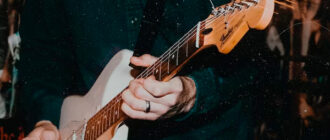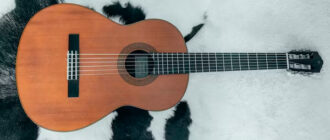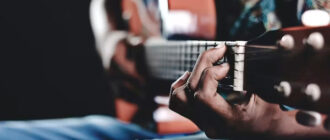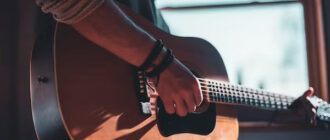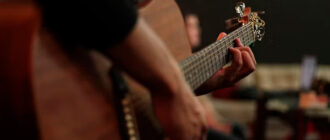We’ve all heard the fingerstyle guitar in timeless tunes like Fleetwood Mac’s “Landslide” and Simon & Garfunkel’s “Scarborough Fair / Canticle.” Instead of using a pick to strike the strings, fingerstyle guitarists pluck the strings with their fingers.
The technique known as fingerstyle is typically used with a classical and acoustic guitar. What about fingerstyle on an electric guitar, though? Is it a terrible idea playing electric guitar without a pick?
Fingerstyle electric guitar playing depends on the player’s musical taste and personal preferences. The majority of electric guitar players begin by learning to play guitar using a pick. An advanced technique known as fingerstyle is mostly applied to classical and acoustic guitar. But some skilled electric guitar players like fingerstyle playing.
Please continue reading to learn more about fingerstyle electric guitar playing, including its benefits and drawbacks, how to get started, and well-known fingerstyle electric guitarists.

Is it time to ditch the pick?
Pros: you don’t need a bass player!
Let’s look at the benefits of playing electric guitar without a pick first.
- You may play multiple notes simultaneously on various strings more easily by using just your fingers. It is more exact to pluck two or more strings at once rather than play them with a pick, especially when muted strings are involved.
- With the thumb, a bass component can be created independently. Folk, blues, and country music are more likely to use this. Additionally, some jazz musicians use their fingerstyle approach to create a powerful beat or bottom line.
- While playing an arpeggio with a pick is undoubtedly possible, the fingerstyle technique makes it simpler in several respects. Your picking fingers are used to playing arpeggios if you have studied any classical music.
- By refining their picking-hand technique, musicians can produce an expressive and distinctive sound without a pick.
- You can play in two different ways that result in two different sounds: with a guitar pick or with your fingertips.
Authenticity
Using a fingerstyle approach on an electric guitar can make some kinds of music feel more authentic:
- For a lot of folk, country, blues, and jazz, you might choose to omit the pick because playing using the fingerstyle technique may sound more appropriate in these genres.
- On the other side, you might not want to perform a ferocious rock solo without a pick (pun intended).
Having the appropriate tools for the work is crucial to becoming an expert in your field.
Without a pick, playing electric guitar improves your picking hand’s muscle memory and finger independence.
Having independent fingers is essential for playing guitar. You need to strengthen and develop the independence of your fingers with your fretting hand to play scales, chords, and riffs well.
Gaining finger independence with your picking hand enables you to play rhythm, bass lines, arpeggios, and chords.
If you want to master fingerstyle guitar, you must learn to develop some independence between your fingers and thumb.
You can create muscle memory in your fingers through repetition and practice, enabling them to move and function naturally. As a result, playing guitar can become more technical and expressive and progress toward expertise.
Cons: fake nails, gross
Having established the benefits, let’s examine some drawbacks of playing an electric guitar without a pick.
- Repetition of a single note and phrase on a single string is more challenging when you play guitar with your fingers. Fast solos are simpler to perform with alternate picking and a pick than just your fingers.
- For a reliable picking technique, you must keep your fingernails at a constant length. Additionally, your nails may become damaged by higher gauge guitar strings. Even some players have false nails!
- Your playing without a pick can sound erratic without practice and improvement. Your fingers may move unevenly, and varied fingernail lengths might produce distinct noises.
- What if you’re not the lead musician? So playing rhythm guitar will be a lot simpler if you use a guitar pick. Using a pick for rhythm guitar sections will probably be simpler if you are playing rock or pop songs.
- Notes struck with a pick rather than your fingertips will sound louder since a pick is tougher than your skin. Your fingernails, on the other hand, can be just as loud as a pick.
Fingerpicks
Remember that there are several types of materials, thicknesses, and shapes available for picking. You can alter your tone and use particular choices for particular tasks thanks to the variety. For instance, you might choose a lighter pick for fast and intricate solos and a heavier pick for strumming and chords.
Because it’s simpler initially, beginning electric guitarists frequently find themselves playing with their fingers rather than a pick. But sometimes the simplest solution isn’t the best. A skilled musician is knowledgeable about every facet of their instrument.
Knowing how to pluck an electric guitar offers you the power to select the best technique for the type of music you are performing.
The last thing you want to happen is to get into a style of a genre.
However, fingerstyle, also known as fingerpicking, is limited to acoustic guitars, but this is not the reality. Although fingerstyle can be played on an electric guitar, it’s not the case.
Playing with a pick VS playing with your fingers (fingerstyle)
Neither a correct manner nor a wrong way to play the guitar exists.
The solution to the pick vs. fingerstyle debate is straightforward: choose whichever method suits you best. Think about your playing style, song genre, and desired guitar sound.
Hybrid choosing is a third choice that we haven’t yet covered.
Instead of using just one or the other, hybrid picking involves using both your fingers and a pick. Although hybrid picking is a more complex method, it’s a fantastic approach to have a varied tone and add some freedom to your playing.
It’s critical to focus on your strengths rather than your faults. A creative space is music. When it comes to playing the electric guitar, many various strategies can be used.
How to play electric guitar without a pick
When playing an electric guitar without a pick, there are many distinct playing genres and styles to consider.
To get started, let’s look at the fundamentals today. It all comes down to paying attention to what your strumming hand is doing while you play fingerstyle electric guitar. Your fretting hand technique will largely stay the same.
What do you need?
- An electric guitar
- A song
- A desire to learn
Which finger matches each string?
It’s crucial to first understand which string corresponds to each finger.
When playing fingerstyle, your thumb controls the bottom three strings, sometimes known as the bass strings. Your first three fingers control the treble strings, which are the top three strings. Your pinky finger is firmly positioned.
Depending on the genre and the player’s preferences, this will change.
Here, we’re looking at a standard fingerstyle method as opposed to a classical guitar technique or a Michael Hedges-inspired percussive approach.
Your fingers and strings are assigned as follows (note the string numbers; we’ll need them later):
Guitar string, string number, finger assignment:
- E, 6, Thumb
- A, 5, Thumb
- D, 4, Thumb
- G, 3, Index
- B, 2, Middle
- E, 1, Ring
Playing a fingerstyle rhythm
It’s time to learn some fundamental fingerpicking patterns now that your fingers are connected to the correct strings.
The finger-picking patterns that demonstrate when to play each string are listed below. These stats are essential now.
Remember that your root note (for some chords) will be the E string, whereas for other chords it can be the A or D string. Therefore, be careful to play the chord’s appropriate root note.
Basic fingerstyle patterns
Thumb, Index, Middle, Ring, repeat is a standard starting pattern. This results in a simple, rolling chord progression. You can experiment by placing your thumb on the fifth string of a C chord. Try a D chord as well, starting with your thumb on the fourth string.
Try the same pattern while switching your thumbs on the repeat to provide some diversity. Try 5, 3, 2, 1, and then 4, 3, 2, 1 as an example. A C chord can be used to perform this. However, be creative and give some other chords a shot.
Another strategy is to change the bass tone while keeping the treble sound constant. Play the bottom three notes of a G chord, for instance, alternating with the first string. This is how it would appear in notation using the string numbers: 6, 1, 5, 1, 4, 1, and so forth.
The sequence would be 5, 1, 4, 1, 3, 1 if the chord’s root were on the fifth string, as it would be with a C chord.
Do any famous guitarists play without a pick?
Even though using a pick when playing electric guitar is more prevalent, some well-known guitarists choose not to use one at all. It is possible to play electric guitar without a pick and still produce a very expressive and powerful tone.
Mark Knopfler
Mark Knopfler, one of my favorite guitarists, invented the fingerstyle on the electric guitar while performing as the lead singer of Dire Straits. After Dire Straits, Knopfler launched a solo career, and his distinctive playing can be heard on tracks from his debut solo album to the present.
Knopfler has a lyrical and deep sound. Just play “Brothers in Arms” in your ears.
Thanks to Knopfler’s guitar, the song is extremely evocative from the somber intro through the solo.
The guitar contributes another voice to the song by fusing loudness peaks and delicate phrases.

Frequently asked questions
1. Is it okay to play guitar without a pick?
That’s perfectly OK to play guitar without a pick. Even the most adaptable musicians do it quite often. Do both! There is no way to determine which is superior.
2. Is it okay to not use a pick when playing an electric guitar?
Picks are required when playing guitar with steel strings, and they are also required while playing other instruments. Players who play without picking may have finger pain after each concert or training.
3. Can you play electric guitar with just fingers?
The benefit of many myths about fingerpicking or fingerstyle is that they are only applicable to acoustic guitars. But you may also play electric guitars!
4. Can you strum an electric guitar without a pick?
Put your thumb and first finger together. Your nails are struck with both sides of the string when you move in this manner, imitating the pick. Additionally, you can swing your arm.
And it’s also fantastic if you decide to strum the guitar without a pick because you can eliminate the forceful approach a pick adds when playing chords.
Conclusion
You now know a couple of different techniques for playing guitar without a pick. Each method has advantages and disadvantages, so you must determine which is ideal for you. Try out each one and see how it fits into your music. The amount of work you can accomplish playing guitar without a pick might surprise you.
You want to play an electric guitar without a pick if you enjoy blues music! The majority of your audience prefers listening to pleasant music. You can create smooth music by playing the electric guitar. Therefore, if you enjoy quiet music, playing the electric guitar without a pick is the option for you.

